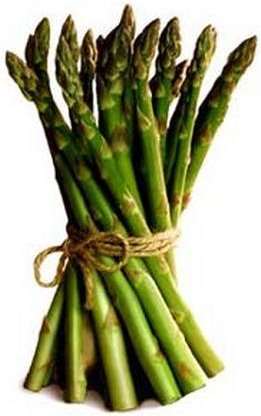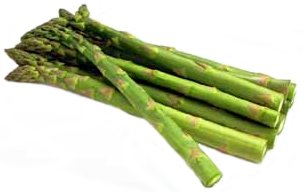

Asparagus

(Name applied by Theophrastus.) Liliaceae (Asparagaceae). A genus of perennial, rhizomatus herbs, shubs or climbers, usually with fusiform tubers. Stems erect, spreading, or climbing. True leaves small, scale-like, emerging at the nodes, with hardened bases, often spine-like; leaves subtend green leaf-like, awl-like, or thread-like cladophylls, solitary or in clusters of 3-50 at the nodes of the leaf axils. Flowers inconspicuous, bisexual or functionally unisexual, green, white or yellow, solitary, paired or borne in clusters among the cladophylls, occasionally in terminal umbels, or in racemes borne on the older shoots; flower stalks distinctly jointed; tepals 6, widely spreading or basally united to form campanulate perianth; stamens 6, free, filaments borne at base of tepals; anthers versatile; ovary superior, 3-celled. Fruit usually a spherical 1-6-seeded berry. Old World. CultivationThe ornamental Asparagus are grown for their fine, feathery foliage, often used in bouquets and floral arrangements, although the hardier species, which are grown easily in any good garden soil, give attractive textural contrasts in the flower border. Asparagus species vary considerably in hardiness, from those tolerant of temperatures below –20ºC, Asparagus pseudoscaber, and almost as hardy Asparagus trichophyllus and Asparagus verticillatus, to more tender Asparagus filicinus and Asparagus lucidus, these still hardy between –10 to –15ºC. Of the remaining species most thrive in the cool glasshouse, minimum 7ºC, with those from warmer climates such as Asparagus setaceus and Asparagus madagascariensis needing warm glasshouse conditions, 13-16ºC. Asparagus densiflorus is a commonly grown basket plant; it will endure the harshest treatment. Grow under glass in bright indirect light or with partial shade in a fertile loam-based mix with additional sharp sand, water plentifully when in growth and maintain good ventilation. Training stems up string or wire will help prevent tangled growth and render cutting easier. Propagate by seed or division. Asparagus officinalis originated in the Eastern Mediterranean region and occurs wild in maritime areas throughout Europe. It has been used for over 2000 years, first as a medicine and later as a food crop. Cultivation is favoured by the presence of a cool winter season when the plant remains dormant and the developing shoots are harvested in the spring. However, in warmer regions, round-the-year cropping is possible, providing a balance is established between canopy and shoot development. The main commercial production areas in Europe are in France, Italy and Germany. Other important production areas include the US and Mexico. Young shoots may be boiled and served whole or made into soup. They may also be processed by freezing or canning. There are national differences in colour preference, and colours can vary from green when shoots develop above ground, to white when cut completely below the soil surface before emergence. Site selection is critical since the crop may continue undisturbed for 20 years or more. The soil should be deep and well drained. Coarse sandy soils are more suitable than heavy ones. The soil pH should be 6.5 or above and should be raised by liming if necessary. The addition of farmyard manure is beneficial, particularly on lighter soils. The site should be clear of perennial weeds before planting. 
Plants are propagated from seed but direct seeding is not recommended as germination is slow and emergence poor. The crop is best established from one-year-old crowns either obtained from specialist propagators or raised in separate seedbeds. A seedbed should be prepared in the autumn, digging in well-rotted farmyard manure or compost. Seeds should be sown thinly about 1-2cm deep in the spring and later thinned to 30cm apart. The young plants should be kept well watered and weedfree throughout the growing season. The foliage should be cut back in the autumn and the plants established in their permanent bed during the following spring. An alternative method for establishing the crop is to sow seed under protection in winter at 25ºC and grow plants on in 7cm pots for planting out in early summer. Being dioecious, plants produced from seed are a mixture of males and females. As a consequence the female plants in the production bed will produce seed and the resulting progeny, if allowed to develop, will reduce the overall quality of spears. Seedlings should therefore be removed from the production beds along with weeds. Male plants produce higher yields and one approach to the problem of seeding is to select male plants only from the nursery beds. As seedlings are not easily sexed during the first year, this usually necessitates growing plants on for a second year when plants bearing female flowers can be destroyed. Recent developments in tissue culture may make high-quality all-male lines available in the future. Crowns can either be grown on the flat or ridged on rows. Ridging is preferable, as it helps in the control of weeds and improves surface drainage. Crowns are planted 10cm below the surface in rows 60cm apart with an in-row spacing of 30-40cm. The higher the planting density the greater the yield, although the diameter of individual spears is reduced. Soil is pulled into ridges over the rows during the autumn following planting and gradually increased over the following two seasons. Where white spears are required the final soil depth should be greater than for green spears. Harvesting can commence one year after planting but could be confined to 3-4 weeks, following which the canopy should be allowed to develop to build up the crowns. In subsequent years the cropping period can be extended to 8-10 weeks. The spears are cut with an asparagus knife when approximately 25cm long, either white when the tip is just visible or at a later stage when a proportion of the shoot will have turned green. In the autumn, foliage should be cut to 2cm of the soil level and the area mulched with well-rotted manure or compost. A balanced fertiliser can be applied in the spring to maintain fertility. Fresh asparagus has a short storage life but this can be extended to three weeks at 2ºC and high relative humidity. The crop can be advanced in the field by covering with clear plastic to raise soil temperature. This is not to be recommended in areas with a high frost risk as the spears which emerge early will be susceptible to damage. There are many cultivars to choose from, including ‘Connover’s Colossal’, recommended for sandy soils, and ‘Argenteuil’ and ‘Giant Mammoth’ for heavier soils. ‘Martha Washington’ has long thick spikes. The use of tissue culture to maintain separately pure male and female lines has made it possible to produce F1 hybrids and a number of promising selections are becoming available such as ‘Cito’, ‘Franklim’, ‘Jersey Giant’ (all male), ‘Lucullus’ and ‘UC 157’. Yields vary considerably but average 2-4kg/m². 
The main pests are both adults and larvae of the asparagus beetle (Crioceris asparagi), which damage shoots and foliage. The most important disease of asparagus is rust, which can be so severe on the summer growth in wet seasons as to jeopardise the following crop. Diseased tops should be cut down in autumn and burnt to prevent carry over to the next season. Shoots may be affected by grey mould blight. Wilt, root rot and decline of beds can be serious and other root rots include violet root rot and black root rot. Asparagus officinalisASPARAGUS. Stem to 1m, herbaceous, usually erect, much-branched, unarmed; stem and branches glabrous, branches green. Leaves with small, hardened, conical bases; cladophylls 1-2.5cm, terete, filiform, borne in clusters of 4-25 at each node. Flowers unisexual, green-white, drooping, axillary, in clusters of 1-4; peduncles arching downwards, mostly exceeding cladophylls, jointed at or about the middle, or just below; perianth 4-6mm. Fruit a bright red, 2-4-seeded berry, 6-10mm. Europe, Asia, N Africa. Z4.
|
Home
Grow Nuts
Grow Herbs
Grow Fruit
Cyberian Index
If you like this website and want one of your own contact
Cyberian All information correct at
time of publication and open to updates as necessary. No part of this website,
or its vectors, may be produced in any shape or form, using any type or design
of medium, system, equipment or otherwise without the prior written consensual
notice of the Cyberian. Any breach of these requirements will result in the
appropriate action. If in doubt, e-mail contact is recommended.
Some components of this website were obtained as open-source software and are
used in the same non-profit manner on this website.